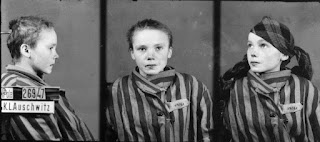Czeslawa Kwoka, the 14-year-old inmate of Auschwitz, 1942 Czesława Kwoka in 1942 or 1943
Czesława Kwoka in 1942 or 1943.
Czeslawa Kwoka, age 14, appears in a prisoner identity photo provided by the Auschwitz Museum, taken by Wilhelm Brasse while working in the photography department at Auschwitz, the Nazi-run death camp where some 1.5 million people died during World War II.
She died at Auschwitz-Birkenau in German-occupied Poland and is among those memorialized in the Auschwitz-Birkenau State Museum indoor exhibit called ‘Block no. 6: Exhibition: The Life of the Prisoners’. (Here you can check a heartbreaking photo collection of the Holocaust).
Czeslawa was a Polish Catholic girl, from Wolka Zlojecka, Poland, who was sent to Auschwitz with her mother in December of 1942. She was deemed a political prisoner for living in Zamosc, the location of a future German colony.
The cut on her lip in picture two came from being struck by a female Kapo for not speaking German which she did not know. (Speaking Polish was outlawed in 1939.)
Czesɫawa, was only in camp three months before she perished, less than one month after her mother, Katarzyna Kwoka (prisoner number 26946) did, due to unknown circumstances (there is speculation that lethal injection was used).

Masterfully colorized by Marina Amaral.
Both of their names can be found on a list of deceased female prisoners who were thought to be associated with the camp resistance.
Photographer (and fellow prisoner) Brasse recalled photographing Czeslawa in a 2005 documentary: “She was so young and so terrified. The girl didn’t understand why she was there and she couldn’t understand what was being said to her. So this woman Kapo (a prisoner overseer) took a stick and beat her about the face.
This German woman was just taking out her anger on the girl. Such a beautiful young girl, so innocent. She cried but she could do nothing.
Before the photograph was taken, the girl dried her tears and the blood from the cut on her lip. To tell you the truth, I felt as if I was being hit myself but I couldn’t interfere. It would have been fatal for me.”
The rod in the first picture was used to keep the subject still and at the right distance from the camera. Those kinds of devices were widely used in the early days of photography when the photographic plates weren’t so sensitive and long exposures had to be used.
(Photo credit: Auschwitz-Birkenau State Museum / Wilhelm Brasse / The colorized version by Marina Amaral / Wikimedia Commons).



.jpg)
Comments
Post a Comment